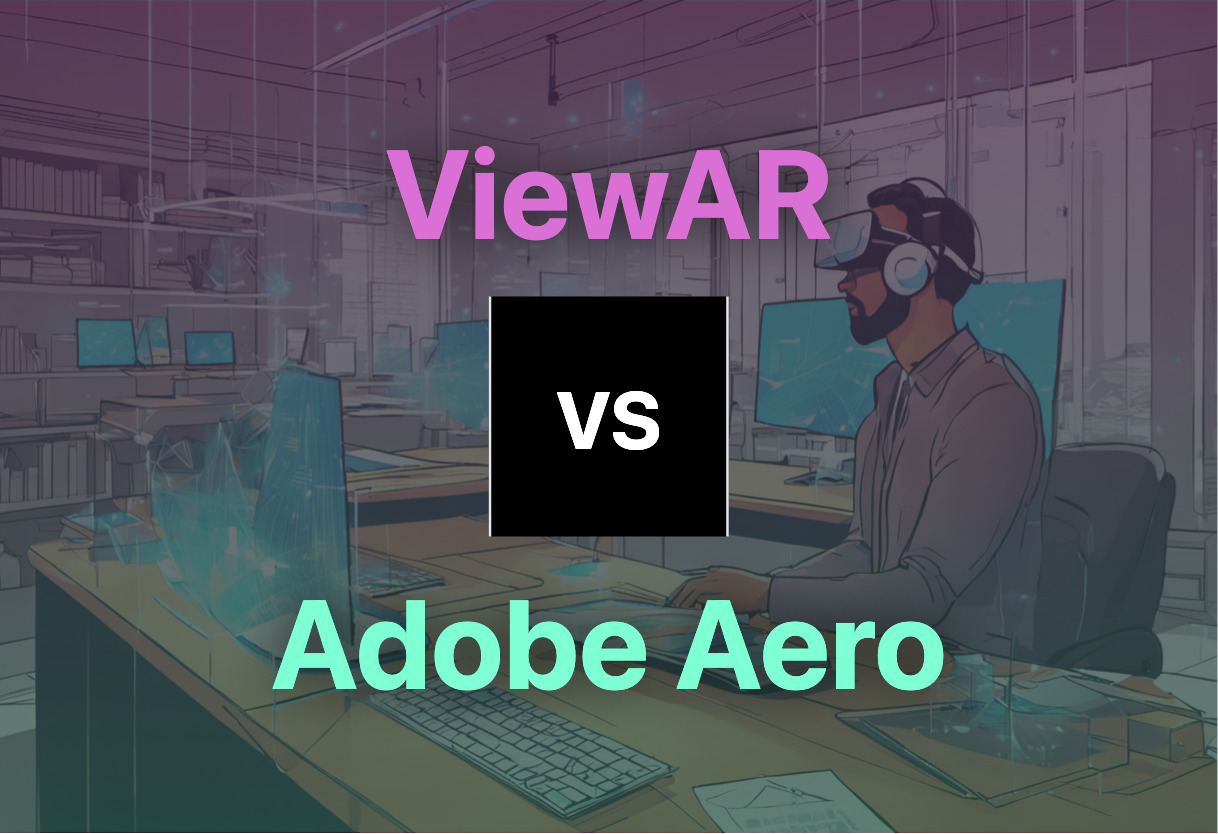If you require advanced, customizable AR solutions and don’t mind some additional coding, ViewAR’s robust features and hardware-free navigation make it a prime choice. For simplicity, intuitive design and seamless Adobe Creative Cloud integration, choose Adobe Aero. However, note Aero’s current iOS device restriction.

Key Differences Between ViewAR and Adobe Aero
- Established AR creator: ViewAR with customized, complex solutions versus Adobe Aero’s streamlined approach.
- Platform compatibility: ViewAR supports multiple platforms, Aero is exclusive to iOS devices (current).
- Navigation capabilities: ViewAR offers sophisticated indoor navigation; Aero focuses on basic asset placement and triggers.
- Integration: Aero integrates flawlessly with Adobe Creative Cloud, ViewAR partners with Matterport for enriched spatial capabilities.
- Support: ViewAR provides more extensive developer support options; Adobe Aero’s simplicity aims at lesser support requirements.
| Comparison | ViewAR | Adobe Aero |
|---|---|---|
| Target Applications | Remote assistance, product visualization, indoor navigation/guidance, Industry 4.0 and IoT | Art, education, marketing |
| Appreciation | ViewAR is recognized for INDOAR | High overall user appreciation |
| Opportunities | Partnered with Omnia for aiding businesses in digital transformation | Simplifies AR development, beneficial for those with limited coding skills |
| System Support | Multiplatform support, web-browser support | iOS 16+ support |
| Integration | Matterport Model API | Adobe Photoshop, Illustrator, other Adobe Creative Cloud applications for content input |
| Key Features | AR solutions with self-service portal/SDK for customizations | Intuitive gestures for asset placement, rotation, scale |
What Is ViewAR and Who’s It For?
ViewAR, based out of Austria, is making strides in the AR market since 2011 by fashioning a range of AR solutions with customizability in the spotlight. This tech marvel uses advanced visual recognition to establish user locations, thereby enabling truly immersive AR experiences. With its top-tier products such as INDOAR, largely used in the Vienna Technical Museum, ViewAR is the go-to choice for industries seeking optimized processes and enhanced customer interactions.
From remote assistance to indoor navigation, ViewAR offers a plethora of solutions while never compromising on their state-of-the-art technology. Ideal for businesses undergoing digital transformation and industries keen on utilizing the newest AR technologies, ViewAR is bringing the future closer.

Pros of ViewAR
- Wide range of AR solutions
- Multiplatform and web-browser support
- Advanced technology like real-time AR positioning
- Live AR positioning function without additional hardware
Cons of ViewAR
- Advanced functionality might pose a steep learning curve for some
What Is Adobe Aero and Who’s It For?
Adobe Aero is the answer for anyone looking to dip their toes into the world of AR without the prerequisite of coding or 3D design knowledge. With its seamless integration with Adobe Creative Cloud applications, Aero is your best ally in crafting real-world AR experiences.
Adobe Aero stands out with its promise of simplicity and compatibility, not only attracting artists, educators, and marketers, but breaking down barriers between imagination and reality for all. Even though currently limited to iOS, Adobe plans a future filled with Android device support, 3D scanning, more AR platform integrations, and so much more.

Pros of Adobe Aero
- Simplifies AR development
- Intuitive interface and ease of use
- Compatibility with Adobe Creative Cloud suite
Cons of Adobe Aero
- Currently only available to iOS devices
- Some potential bugs have been reported
The Final Word: ViewAR vs Adobe Aero
When exploring the provinces of augmented reality, the choice between ViewAR and Adobe Aero is less about superiority and more about compatibility with unique user needs. Let’s unravel this puzzle for different end-users:
The AR Developers and Coders
If you’re a seasoned coder in search of a robust and customizable AR platform, your compass should point towards ViewAR. With its self-service portal/SDK, multiplatform & web browser support, this AR giant also boasts an impressive resume of AR solutions such as remote assistance, IoT integration, and innovative indoor navigation system. Perfectly suited for advanced developers.

The Business Innovators and Industrialists
ViewAR edges out Adobe Aero here, again. Its seamless integration with matterport, a cutting-edge AR solution for product visualization, remote assistance, and data visualization makes it a solid choice for businesses keen on digital transformation. Proof? Its global expenditure rose to a whopping $12 billion in 2020.

Creative Artists & Designers
For the more creatively inclined, Adobe Aero stands out as the indisputable champion. The tool’s intuitive usage, integration with Adobe Creative Cloud, ability to animate, and interactive experiences make it a gateway for artists and designers to step into the AR world.No coding prowess? No problem with Adobe Aero.

In a nutshell, if you’re an AR titan seeking flexibility, go for ViewAR. However, if you’re an artist diving into AR, Adobe Aero would be your ally. It’s up to you to choose the AR tool fitting your unique requirements like a glove.
Patrick Daugherty
Content writer @ Aircada. Merging AR expertise with a love for late-night gaming sessions.





